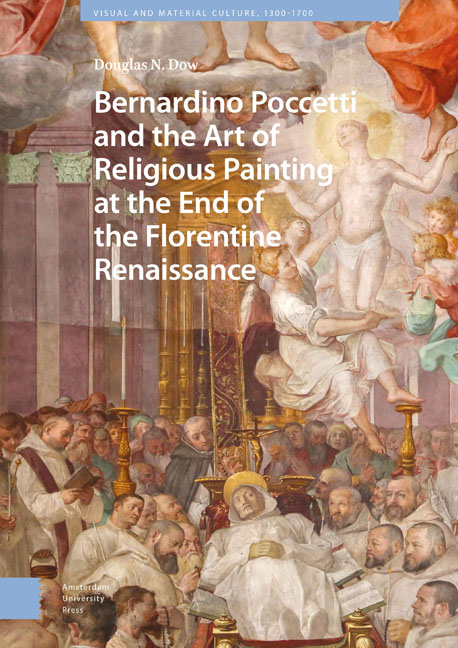Book contents
- Frontmatter
- Contents
- List of Illustrations
- List of Abbreviations
- Acknowledgments
- Introduction: ‘Il primo huomo da dipingere in fresco, che sia in questi paesi’: Bernardino Poccetti and the Historiography of Florentine Painting during the Late Renaissance
- 1 ‘Grandemente inclinato all’Arte del Disegno’: Filippo Baldinucci’s Biography of Bernardino Poccetti
- 2 ‘Le prime cose lodevoli molto’: Bernardino Poccetti’s Early Work and the Frescoes from the Life of Saint Dominic in the Chiostro Grande, Santa Maria Novella
- 3 ‘Locum ecclesiae designavit, quae Ioannis et uxoris pecunia extructa est’: Bernardino Poccetti and the Decoration of the Canigiani Chapel in Santa Felicita
- 4 ‘Miracula et alia id genus’: Bernardino Poccetti’s Frescoes in the Church of San Lorenzo at the Certosa del Galluzzo
- Color Plates
- 5 ‘L’inventore di dipingere tutte le muraglie della nostra chiesa’: Bernardino Poccetti and the Sixteenth-Century Decoration of Santa Maria del Carmine
- Conclusion
- Bibliography
- Index
4 - ‘Miracula et alia id genus’: Bernardino Poccetti’s Frescoes in the Church of San Lorenzo at the Certosa del Galluzzo
Published online by Cambridge University Press: 13 February 2024
- Frontmatter
- Contents
- List of Illustrations
- List of Abbreviations
- Acknowledgments
- Introduction: ‘Il primo huomo da dipingere in fresco, che sia in questi paesi’: Bernardino Poccetti and the Historiography of Florentine Painting during the Late Renaissance
- 1 ‘Grandemente inclinato all’Arte del Disegno’: Filippo Baldinucci’s Biography of Bernardino Poccetti
- 2 ‘Le prime cose lodevoli molto’: Bernardino Poccetti’s Early Work and the Frescoes from the Life of Saint Dominic in the Chiostro Grande, Santa Maria Novella
- 3 ‘Locum ecclesiae designavit, quae Ioannis et uxoris pecunia extructa est’: Bernardino Poccetti and the Decoration of the Canigiani Chapel in Santa Felicita
- 4 ‘Miracula et alia id genus’: Bernardino Poccetti’s Frescoes in the Church of San Lorenzo at the Certosa del Galluzzo
- Color Plates
- 5 ‘L’inventore di dipingere tutte le muraglie della nostra chiesa’: Bernardino Poccetti and the Sixteenth-Century Decoration of Santa Maria del Carmine
- Conclusion
- Bibliography
- Index
Summary
Abstract: When they renovated their church at the charterhouse in Galluzzo outside of Florence, the Carthusians commissioned Bernardino Barbatelli (called Poccetti, 1553–1612) to decorate the space with some of the earliest monumental images from the life of their founder, Saint Bruno of Cologne (c. 1030–1101). These scenes of Saint Bruno highlight the important role that the Carthusians had played in sacred history, and make a case for their continued relevance as the Roman Church faced the threat of Protestantism. In the process, the images also celebrate other important figures from Carthusian history, holding them up as examples of how their eremetical order had loyally served the Church in the past and would do so in the future.
Keywords: Bernardino Barbatelli (called Poccetti); Saint Bruno of Cologne; Carthusians; bishops; Certosa del Galluzzo
Although its position on top of the Monte Acuto where it overlooks the traditional route to Siena and Rome gives the Certosa del Galluzzo the appearance of a remote monastery, the charterhouse is located only a little over four kilometers from Florence’s southernmost city gate, known in the Cinquecento as the Porta di San Piero in Gattolino (Fig. 4.1). Indeed, it appears that the distance to town from the Certosa is not so great that it could not be managed on foot by a man in his late thirties, a painter by trade, even if he was burdened with a substantial payment that had been made to him in coin. That this painter, Bernardino Poccetti, came to be on the Via Senese with his earnings from the work he had done for the Carthusians in Galluzzo, is partly the result of the changed landscape of sixteenth-century Catholicism, and, in particular, the role taken on by the Carthusian order as the wider Church pursued its campaign of reform and renewal.
The foundation of the Certosa del Galluzzo dates to the Trecento, when Niccolò Acciaiuoli (1310–1365) made the initial bequest for the monastery. A Florentine merchant living in Naples in the 1330s, Acciaiuoli had assumed a powerful and high-ranking position within the Angevin court, and his decision to found a charterhouse outside Florence was most likely inspired by the Angevins’ patronage of the Certosa di San Martino, which had been founded by Charles, the Duke of Calabria, the oldest son of Robert the Wise.
- Type
- Chapter
- Information
- Bernardino Poccetti and the Art of Religious Painting at the End of the Florentine Renaissance , pp. 169 - 176Publisher: Amsterdam University PressPrint publication year: 2023



